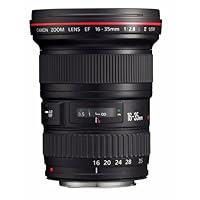
Average Reviews:

(More customer reviews)I have owned both this and the original version. The new lens is better in the corners and flares less but the corners are still a little soft at f2.8 and you can get the lens to flare a little if you try. I haven't seen the loss of clarity above 20mm that others reported. Perhaps you would see a slight difference in eyelashes if you did a lot of portraits but this is probably not the best choice for a portrait lens. It is a somewhat better lens for shooting landscapes and other shots where edge to edge clarity is important.
But the differences between the two versions are minor and in some instances irrelevant. If you don't shoot a full frame camera the soft edges don't appear in the photo. And flare is a minimal issue at most. It rarely appears and is easy to fix in Photoshop if it does. I would opt for the original if I didn't shoot full frame based on the price difference alone.
My only problem with the original was when I had to shoot hand held. Sometimes you can't bring a tripod along which rules out shooting at f16 or 22 so I occasionally ended up with shots that were soft in some of the edges. The new lens will solve that. That is the only reason I decided to upgrade.
I haven't used many other lenses in the same range so I can't compare quality with other makers but I'm not aware of anything reputed to be better. I have Canon primes as well as other Canon zooms and in actual use all are generally close in quality. I use the primes if possible when I plan to crop or enlarge a lot but I could still get by nicely with the zooms.
So, if you shoot less than full frame or if price is an issue, get the original. If you shoot full frame but need maximum clarity in the center (portraits for example), test both versions first. If you shoot full frame and need maximum edge to edge clarity, go with the new lens.
Update: Having shot this lens for a long period I would discount the comments about problems above 20mm. I owned the first version as well and I don't see a difference in the 20mm to 35mm range. On the contrary, I am increasingly impressed with the image quality and sharpness of this lens throughout the range. I recently used it into a very narrow slot canyon where I couldn't take more than the camera and the lens attached to it and took shots from 16mm up to 35mm that all came out very sharp and rich. Granted I wasn't shooting wide open because I needed lots of depth of field but the point is the lens delivered the best shots of that trip. In terms of versatility, this lens is unmatched for wide angle use by Canon owners. I also have the 14mm f2.8 II, 17mm f4. TS/E and 15mm fisheye for comparison. This is the one wide angle lens I always take along.
Click Here to see more reviews about: Canon EF 16-35mm f/2.8L II USM Ultra Wide Angle Zoom Lens
Broaden your perspective with the Canon EF 16-35mm ultra-wide-angle zoom lens. Specifically designed for improved edge-to-edge image quality that meets the strict requirements of professional and high-end amateur photographers alike, the lens lets you bring more area into focus while providing greater depth of field. The lens features three high-precision aspherical lens elements--ground, replica, and GMo--that produce even better image quality than the original Canon EF 16-35mm USM lens. The circular aperture, meanwhile, produces a beautiful and natural background blur when shooting at wider apertures. Other details include internal focusing, a ring-type ultra-sonic monitor (USM), and new AF algorithms for fast and quiet autofocusing. The lens carries a one-year warranty.
Focal length: 16-35mm
Maximum aperture: f/2.8
Lens construction: 16 elements in 12 groups
Diagonal angle of view: 108 degrees (at 10 feet) to 63 degrees
Focus adjustment: AF with full-time manual
Closest focusing distance: 0.92 feet
Filter size: 82mm, P=0.75mm/1 filter
Dimensions: 3.5 inches in diameter, 4.4 inches long
Weight: 1.41 pounds
Click here for more information about Canon EF 16-35mm f/2.8L II USM Ultra Wide Angle Zoom Lens

0 comments:
Post a Comment